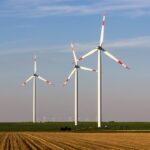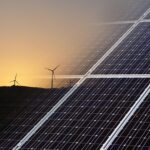Green Energy Revolution: How Renewable Solutions Are Reshaping Our Future
In the midst of the 21st century, the world stands on the precipice of a revolutionary transformation—the Green Energy Revolution. Driven by the urgent need to combat climate change, reduce dependence on fossil fuels, and create a sustainable future, renewable energy solutions are not just emerging trends; they are the cornerstone for the future of energy production and consumption. This article delves into the significant impact of renewable energy sources, the technologies behind them, the economic implications, and their role in reshaping our society.
The Urgent Need for Renewable Energy
Climate change poses a critical challenge to global health and ecology. According to the Intergovernmental Panel on Climate Change (IPCC), rising temperatures, environmentally destructive weather patterns, and loss of biodiversity are direct results of increased greenhouse gas emissions, primarily from burning fossil fuels. This has propelled nations, industries, and individuals to seek sustainable alternatives that will help mitigate these harmful effects.
Renewable energy sources, such as solar, wind, hydro, geothermal, and biomass, offer an essential solution. They emit little to no greenhouse gases during operation and increase energy independence by reducing reliance on finite fossil fuel resources. Moreover, renewables promise economic benefits by creating jobs and stimulating technological advancements.
Types of Renewable Energy Sources
Solar Energy
Solar energy harnesses sunlight to generate electricity or heat. Photovoltaic (PV) panels convert sunlight directly into electricity, while solar thermal systems use sunlight to produce heat for residential or industrial purposes. The technology is continually evolving, including innovations like solar tiles and concentrating solar power (CSP), which uses mirrors to focus sunlight and generate steam for electricity production.
One of the most compelling aspects of solar energy is its scalability. It can be deployed in various settings, from small residential rooftops to massive solar farms, making it accessible for diverse communities and businesses. Moreover, the declining cost of solar technology has made it an attractive option for homeowners and commercial entities alike.
Wind Energy
Wind energy captures the kinetic energy produced by wind through turbines that convert it into electricity. Wind farms, both onshore and offshore, have become increasingly popular due to their relatively low environmental impact and the abundance of wind resources.
The advancement of turbine technology has played a crucial role in increasing the efficiency and reliability of wind energy. Modern turbines are taller and equipped with larger blades, allowing them to capture more wind energy and generate more electricity. As wind energy becomes more cost-competitive, it is quickly gaining ground as one of the leading sources of renewable energy worldwide.
Hydro Energy
Hydropower is traditionally one of the oldest and most widely used sources of renewable energy. It utilizes flowing water to turn turbines that generate electricity. Large-scale hydroelectric plants can provide stable, continuous power to the grid, while small-scale hydro plants, known as run-of-the-river systems, can supplement local energy needs without the environmental disturbances typically associated with damming rivers.
While hydropower remains a critical component of many nations’ energy strategies, it is essential to balance the potential benefits with environmental considerations, including aquatic ecosystems and sediment transport. Innovations in fish-friendly turbine technology are being developed to address some of these ecological concerns.
Geothermal Energy
Geothermal energy taps into the Earth’s natural heat. By harnessing steam or hot water from underground reservoirs, this energy source can generate electricity or provide direct heating applications. Geothermal plants operate with a small physical footprint and can provide a reliable base-load power supply, addressing the intermittency issues faced by solar and wind energy.
This renewable source is particularly effective in regions with geothermal activity, such as volcanic areas. However, advancements in enhanced geothermal systems (EGS) are expanding the potential of geothermal energy beyond traditional hotspots, making it a viable option in more diverse geographical areas.
Biomass Energy
Biomass energy derives from organic materials, such as plant and animal waste. This renewable source can be converted into electricity, heat, or biofuels through various processes, including combustion, fermentation, and anaerobic digestion. Biomass plays a unique role in reducing waste while also providing energy, effectively creating a circular economy.
While biomass is often considered carbon-neutral, the sustainability of its sourcing and processing remains critical. Careful management and advancements in technology are necessary to ensure that biomass consumption does not contribute to deforestation or land-use changes detrimental to the environment.
The Impact of Renewable Energy on the Economy
The transition to renewable energy has significant economic implications. The renewable energy sector is one of the fastest-growing job markets globally. From manufacturing and installation to operation and maintenance, the job creation potential within this industry is substantial. In many countries, investment in renewable energy has become a key strategy for revitalizing local communities and bolstering economies.
Moreover, renewable energy sources have shown remarkable cost reductions over the past decade. Achievements in technology and increase in production capacities have resulted in decreased costs for solar panels and wind turbines, making renewables more competitive against traditional energy sources. This is not only beneficial for consumers but also opens new avenues for investment.
Technological Innovations Driving the Green Revolution
The Green Energy Revolution is driven by technological innovations that enhance the efficiency, reliability, and integration of renewable energy systems. These advancements span various fields:
Energy storage technologies, such as advanced battery systems and pumped hydro storage, play a critical role in addressing the intermittent nature of solar and wind energy. By storing surplus energy produced during peak generation hours, these systems ensure that clean energy remains available when demand is high.
Smart grid technology enhances the efficiency of electricity distribution by using digital communication to monitor and manage energy flow. Smart meters and grid management systems increase energy efficiency, facilitate the integration of distributed energy resources, and empower consumers to manage their energy use effectively.
Innovations in energy efficiency and demand-side management technologies can significantly reduce energy consumption, minimizing overall demand and complementing the deployment of renewable energy generation.
The Role of Policy and Regulation in the Transition
Government policies and regulations play a crucial role in fostering the transition to renewable energy. International agreements, such as the Paris Agreement, set globally recognized targets for reducing greenhouse gas emissions and promoting renewable energy adoption. National and local governments implement policies, such as tax incentives, subsidies, and renewable portfolio standards, to accelerate the growth of renewable energy markets.
However, achieving a successful transition requires a collaborative approach between governments, industries, and communities. Stakeholder engagement and public awareness campaigns can effectively inform and empower consumers to make sustainable energy choices.
Challenges to Overcome
The path to a sustainable energy future is not devoid of challenges. Integration of renewable energy into existing grids can be complex due to varying generation profiles and the need for infrastructure upgrades. Additionally, the current reliance on fossil fuels entrenched within economic systems can present obstacles to enacting rapid change.
Moreover, concerns over land use and ecological impacts must be addressed to ensure sustainable development of renewable energy projects. Open dialogues and thorough assessments are necessary to balance energy production with environmental preservation.
The Future of Renewable Energy
The future of renewable energy is bright, with innovative technologies and burgeoning markets poised to reshape the global energy landscape. The continued investment and commitment from governments, industries, and communities signal a collective drive towards a cleaner, more sustainable future.
A successful transition to renewable energy will not only reduce emissions and pollution but also create opportunities for economic growth, technological advancements, and social equity. With concerted efforts and a shared vision, the Green Energy Revolution can lead to a thriving planet for generations to come.
Conclusion
As we immerse ourselves in the Green Energy Revolution, it becomes evident that the transition to renewable energy is more than an environmental necessity; it is an opportunity for systemic change across various sectors of society. By embracing renewable solutions, we can reshape our future, ensuring a sustainable, resilient, and equitable world for all. The choices we make today will determine the viability of our planet tomorrow, and the time to act is now. Let us harness the power of the sun, wind, water, and earth to create an energy-rich future that aligns with the values of sustainability and responsibility.










